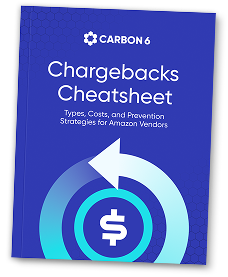Listen to This Article
Preparation, as is said, is half of any battle. This philosophy is no different when it comes to your annual Amazon vendor negotiations. The Amazon AVN (Annual Vendor Negotiation) takes place each calendar year, with the bulk of negotiations occurring at the beginning of the calendar year.
Things kick off in late Q4 when Amazon sends vendors preliminary performance reviews and trade term proposals, but steps can be taken to prepare early, which help set the stage for more favorable outcomes.
There are advantages to beginning your preps as early as Q3.
Key Insights
Prepare
- Q3 presents an opportunity to get ahead of your Amazon AVN.
- Use this checklist to prepare.
- Negotiations are more effective when you understand Amazon’s position and expectations.
Execute
- Though it can be nerve-wracking, it doesn’t need to be. Breaking the negotiation process into 4 phases clarifies your actions.
- Understanding and making use of pre-negotiation audits and preparing key documentation smooths the process.
Your Amazon AVN: The Big Picture
For those who haven’t been through one, an AVN can seem daunting. Also called a Joint Business Plan (JBP), this is definitely a negotiation, so AVN is the most used term. You’ll be going back and forth directly with your contacts at Amazon to reach final working agreements, which determine:
- Amazon Vendor Terms and Conditions
- Marketing Allowances
- Damage Allowances (DA) & Overstock Terms
- Service Program Fees
- Payment Terms & Product Costs (PCOGS)
- Operational Investments
- Performance Metrics
In short, these negotiations set the terms of your relationship with Amazon for the next calendar year.
Who Gets Involved?
Vendor Managers (VMs) are your key, forward-facing contact at Amazon and work directly with vendors. VMs assess metrics like Net Pure Profit Margin growth (Net PPM), revenue (shipped COGS) growth, and operational performance.
Their role includes:
- Reviewing vendor performance and compliance with terms.
- Proposing adjustments to pricing, allowances, and operational agreements.
- Acting as the primary point of contact for vendors during AVNs.
Amazon’s negotiation approach is transactional, which means you may end up in negotiations with different Amazon buyers each AVN cycle. This can make it challenging to build direct relationships.
Understand Amazon’s priorities. During the AVN be prepared to showcase product strengths which will appeal to Amazon and their objectives. Amazon seeks competitive pricing, unique product offerings, and early access to new products. Highlight how your brand supports these goals.
On the vendor side your team may include sales or account managers, finance and operations teams, even legal advisors.
Beyond Vendor Managers, Amazon may also involve their own financial analysts, along with Category Managers, who oversee specific product categories and ensure that terms align with Amazon’s category goals.
Many factors determine who comes to the table during an AVN.
Note: Only your designated Account Administrator in Vendor Central can formally accept AVN terms. Ensure your Primary Contact is always up-to-date for communications. Do this under Settings > Contacts.
Aligning Forces
Plan your strategy around Amazon expectations when prepping for your AVN. Amazon’s focus is more on operational and commercial improvements, whereas your goal as a vendor will be more in the direction of aligning Amazon’s demands to your business needs and capabilities.
For your strategic approach, it’s worth remembering Amazon’s vision: to be customer-centric. How does that align with your own?
Mirroring Amazon’s customer-centric mindset goes a long way toward strengthening your Amazon-Vendor relationship.
Your VMs and Amazon agents are real people you’ll be working and negotiating with, and while you might be sitting across from different people from time to time, they will always have that customer-first culture in common.
Genuinely incorporating that business-view into your own is one more element to add to your operations and planning which can help your negotiations.
“One of the things that Amazon values so well is making sure that the customer is happy.”
~Samantha Welch, Director of Recovery and Operations at Carbon6
Remaining Agile
In the last year things have evolved with the AVN process, including many brands reporting the most recent round of negotiations were more high-stakes than in previous years, with Amazon pushing harder on trade terms. This trend may continue in the coming year.
Trade Terms & Margins: operational and commercial improvements have become a focus for Amazon, leading to a tightening of service program fees, freight contributions and marketing allowances.
Longer Negotiations: AVNs are now lasting over 3 months on average, meaning brands need to be prepared to be flexible during the process.
Data-Driven: not surprisingly, Amazon Vendor Managers, more and more, are prioritizing vendor metrics when assessing agreements.
As with many business processes, early preparation sets the stage for better outcomes.
Why Q3?
While direct negotiations may not be the primary focus in Q3, use this time to refine strategy and prepare for the upcoming Amazon negotiation cycle.
In Q3 vendors should focus on:
A Performance Review: Review and assess things like shipped COGS growth, Net PPM growth, and operational efficiency to understand where improvements are needed.
Strategic Planning: Gather data, lay out strategies and prepare for scenarios to strengthen your negotiation positions.
Marketing & Operational Investments: Go over your marketing allowances, service program fees, and operational investments to align with Amazon’s expectations.
Deduction Audit: Understand what you’re *really* making after all Amazon fees and potential erroneous deductions.
Q3 is the perfect time to get ahead. Analyze past performance and review past AVN results (if this isn’t your first time), and try to anticipate Amazon’s demands.
Before AVN kicks off, get a clear picture of recoverable funds from chargebacks, shortages, and accruals with a Carbon6 Revenue Recovery Audit. No obligation, no risk. Having settlements and other dispute activity in motion will be negotiation gold during AVN discussions.
Ad Hoc Discussions
During this period there may still be occasional ad-hoc negotiations. Though Q3 and Q4 are more about preparation and fine-tuning, if other issues arise — such as supply chain challenges, shifts in the market or other concerns — you might find yourself in mid-year discussions.
Things that could lead to ad hoc negotiations:
- Pricing Adjustments
- New Program Opportunities
- Inventory & Demand Planning
Staying proactive in Q3 ensures vendors have accumulated leverage when formal discussions kick off.
Demystifying the Process
The AVN process typically starts with a kickoff meeting, followed by counteroffers and negotiations, where vendors aim to align Amazon’s demands with their business capabilities.
In preparing for your AVN you’ll want to have certain items in order.
Pre-Negotiation Audits and Documentation
Vendors should conduct thorough audits and prepare key documentation to strengthen their position going into AVNs.
To recap a few points, conduct and prepare:
Pre-Negotiation Audits
- Financial Performance Review, including Net PPM trends, shipped COGS growth. Anticipate expenses Amazon may introduce and how they would affect your margins.
- Operational Efficiency Audit, including an evaluation of chargeback trends and compliance issues, an assessment of supply chain performance, and any Vendor Lead Time (VLT) problems that impact fulfillment.
- Marketing & Investment Analysis, including an audit of Amazon advertising spend and ROI, an assessment of A+ content and Brand Store performance, as well as past seasonal promotions and their impact.
Key Documentation
- Historical Performance Reports (shipped COGS, Net PPM, Buy Box metrics).
- Chargeback & Compliance Records (to negotiate operational fees).
- Marketing Investment Breakdown (to justify ad spend and promotional costs).
- Competitive Benchmarking Data (to compare pricing and profitability).
Provisional CoOp Rates
One of the biggest hidden profit drains for vendors — and a major area where proactive management is crucial — are Provisional CoOp Rates. These are temporary charges Amazon applies to products until a formal CoOp agreement is negotiated.
As Amazon is basically “filling the gap” with these rates, basing them on estimates, they can potentially be much higher than the eventual negotiated rates.
What: CoOp charges are applied to Marketing Development Funds (MDF), Damage Allowance, and Freight Allowance.
Impact: These charges can be significantly higher than negotiated rates. Amazon will retroactively adjust (credit or debit) once new agreements are signed, but with the proper attention you can avoid many of these fees in the first place.
How to Avoid: Set up MDF, DA, & Freight Allowance CoOp agreements before shipping items. Contact your VM ASAP if provisional rates appear or agreements are expiring/incomplete.
Where to Check: In Vendor Central check Payments > CoOp > Provisional CoOp Rates.
The Negotiation
The negotiation process is then broken into four phases.
(1) Preparation
As described above, this is where the vendor reviews past performance, gathers data, plans budgets, and forecasts possible negotiation scenarios and response strategies.
(2) Kickoff Meeting
Wherein Amazon presents an assessment of past performance, introducing trade terms and investment proposals. Be prepared with your counter-offers.
(3) Negotiation Phase
This is where you’ll exchange proposals, negotiate fees for marketing, operational services and Amazon programs. Draw upon the strategies you’ve formulated during your preps.
(4) Escalation and/or Final Agreement
If an agreement isn’t reached, vendors may escalate discussions to higher decision-makers. Once terms are finalized, the Amazon vendor agreement is implemented and monitored.
As you prepare in Q3 it helps to look ahead to each of these phases and begin laying out your gameplan.
Amazon Vendor Awareness
Go into negotiations with your eyes wide open, fully prepared and knowing what Amazon expects. Amazon prioritizes data. Expect them to focus on your metrics and operational efficiency.
If Amazon brings pressure on pricing, be prepared to counter their demands with data-driven arguments. Anticipate pricing scenarios and be ready with your solutions.
Discussions will center around:
- Marketing Allowances (on- and off-platform promotions)
- Service Program Fees (participation in programs like Subscribe & Save)
- Operational Investments (volume incentives, damage allowances, freight contributions)
A simple checklist helps frame objectives.
An Amazon AVN Checklist
Negotiating with Amazon requires a strategic approach, since their process is highly transactional. Follow these checklist items to prepare for your AVN:
☑️ Prepare All Data: Analyze key performance indicators in advance, such as PCOGS Amazon growth (Product Cost of Goods Sold), Net Pure Profit Margin (Net PPM), and operational efficiency, and be ready to reference and call upon accurate, complete data during the negotiation.
☑️ Know Your Budgets: Understand your financial flexibility, your costs, and prepare for a variety of scenarios. Be prepared to respond from a point of full understanding of your own capabilities.
☑️ Know Your Value: What are your strengths in comparison to competitors? Be prepared to highlight your past contributions to Amazon’s marketplace, and additional value you bring to the table.
☑️ The Kickoff Meeting: Expect Amazon to propose terms that may or may not align with your own expectations, and plan for contingencies and how you might respond and be ready with counter-offers.
☑️ Plan Your Options: Use what’s known as a Zone of Possible Agreement (ZOPA) to pre-define a range in which you believe common ground exists and you and Amazon can potentially reach a mutually acceptable deal.
☑️ Control and Measure: Have ready the methods you’ll use to track the impact of negotiated terms, and be prepared to ensure negotiated terms align with your business strategy — and that Amazon follows through on commitments.
☑️ Clearly Define Your Goals:. Amazon prioritizes operational efficiency and customer retention, so align your strategy accordingly.
Fully armed with thorough preparations, the process itself does not need to be a source of worry or confusion. Your AVN is an opportunity to align forces with Amazon and reach the agreements that will set the stage for a new year of expansion.

Enlisting Help
As noted, Amazon relies heavily on metrics. Data like chargeback trends and a record of operational improvement efficiencies can go a long way toward your ability to negotiate lower fees.
If you’re working with a partner like Carbon6 to handle your chargebacks you go into Amazon negotiations with the added confidence of an experienced partner in your corner, one that’s been managing your chargeback fees, shortages, and accruals to Amazon’s exacting standards.
Every advantage helps. When it comes to Amazon AVNs, partnering with expertise gives you an even better position from which to negotiate.








